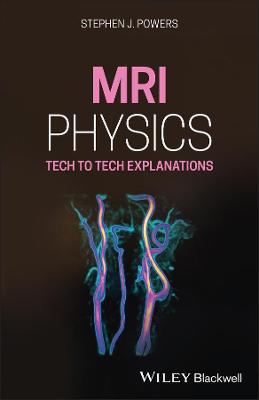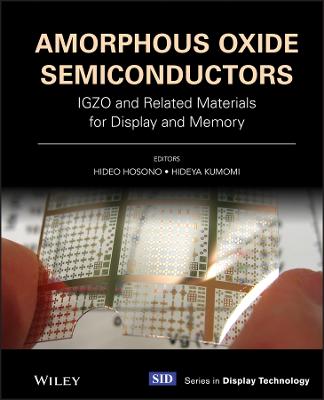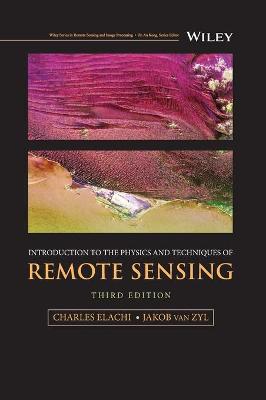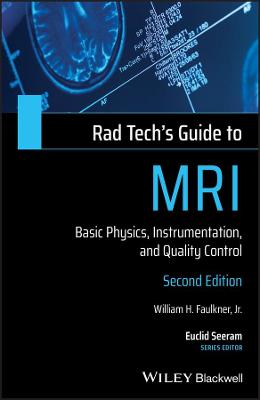MRI Physics
 -15%
portes grátis
-15%
portes grátis
MRI Physics
Tech to Tech Explanations
Powers, Stephen J.
John Wiley and Sons Ltd
04/2021
416
Mole
Inglês
9781119615026
15 a 20 dias
572
Descrição não disponível.
About the Author xv
Preface xvii
Acknowledgements xix
Introduction 1
1 Hardware: Magnet Types and Coils 15
Magnets 15
Coils 17
2 The Basics 23
Why the Hydrogen Molecule? 24
The Net Magnetization Vector 26
MRI is a Sequence of Events 27
Free Induction Decay (FID) 32
Relaxation 33
Proton Density 38
Image Contrast 38
The IQ Triangle: Contrast, SNR, Resolution 39
B0 and B1 43
Free and Bound Protons 44
3 Image Weighting 47
Where Does Image Weighting Come From? 48
Time of Repetition (TR) 50
Time of Echo (TE) 52
TE and TR 54
Why Different TR Ranges for Different Field Strengths? 54
How Does TR Control T1? 55
What Does TR Affect? 56
Interpreting the T1 Relaxation Curve 57
Time of Repetition: Effects of the TR 57
TE: The T1 and T2 of it 58
Interpreting the T2 Relaxation Curve 60
Effects of TE on Image Contrast 62
What Do the Lines on the Curves Really Mean Anyway? 62
One Last Weighting Triangle 65
T1 and T2 Contrast Review 66
4 Introduction to the Basic Pulse Sequences 69
What is a Pulse Sequence? 69
Spin Echo (SE) 70
Gradient Echo/Gradient Recalled Echo (GRE) 73
Line Diagram Anatomy 74
The Ernst Angle 77
5 Multi Echo Spin Echo Sequence 81
Introduction to k-Space 82
k-Space: Phase Encoding 85
With FSE, Watch the Speed Limit! 86
k-Space, ETL, and Image Contrast 87
Filling k-Space 89
Pros and Cons of FSE 89
Another Way to View T2* and 180 degreess 91
Where Do Relaxation and Decay Curves Come From? 92
A T2* Curve Compared to the T2 Curve 93
Metal Artifact Reduction (MARS) 94
Driven Equilibrium: A "Forced T1" 95
3D FSE: CUBE/SPACE/VISTA 97
Single Shot FSE/HASTE 98
6 Tissue Suppression 105
Tissue Saturation versus Suppression 107
Inversion Recovery - Part One: STIR 108
Inversion Recovery: STIR with Vectors 109
Inversion Recovery Part Two: T2 FLAIR 113
IR Sequences: T1 and T2 FLAIR 116
IR Weightings: STIR, T1 and T2 FLAIR 117
Inversion Recovery - Part Two 119
The Rupture View 120
Tissue Saturation: Chemical Shift 121
Chemical Saturation at Low Fields 123
Tissue Saturation: SPAIR and SPIR 124
The Dixon Technique 126
Water Excitation 126
Saturation Pulses or Bands 129
Subtractions 131
Magnetization Transfer 135
IR Prepped Sequences 137
How is an RF Pulse Selective or Non-Selective? 140
Water Excitation Sequences 142
7 The Gradient Echo Sequence 145
GRE Sequence Structure 147
Phase Dispersion and Gradient Reversal 148
Analog to Digital Converter (ADC) 149
GRE Sequence Image Weighting 149
Two Different Kinds of T2 Relaxation 152
The GRE Weighting Triangle 153
GRE and SE Differences 156
Different Gradient Echo Types 157
In and Out of Phase TEs 161
In Phase/Out of Phase at 1.5 T 163
8 Gradient Echo Magnetic Resonance Angiography 167
Time of Flight MRA 168
TOF Angiography: Two Golden Rules 171
Types of MRA Sequences 171
TOF Concept in MRA versus MRV 172
2D versus 3D 172
2D TOF MRAs 175
3D TOF MRAs 176
In-Plane Saturation 178
In-Plane Saturation Avoidance 179
Magnetization Transfer (MT) 181
Options for Better MRAs 183
Phase Contrast MRA 185
9 k-Space 191
What Is Fourier Transform? 192
k-Space Filling 192
10 Echo Planar Sequences 203
Diffusion Weighted Imaging 205
Diffusion Tensor Imaging or White Matter Tractography 215
Susceptibility Weighted Imaging 216
Brain Perfusion 218
Arterial Spin Labeling 222
Spectroscopy 225
11 Geometric Parameters: Trade-offs and Effects on Image Quality 231
Field of View (FOV) Is Your Film Size 232
Nex, ACQ, NSA, and SNR 235
Scan Matrix 237
Frequency Matrix 237
Echo Train Length 238
Echo Spacing 239
Echo Train Balancing 240
Slice Thickness and Slice Gap 242
Fractional Echo 243
Bandwidth 244
Rectangular (Rec.) FOV 249
No Phase Wrap/Phase Oversampling/Fold-Over Suppression 251
Concatenations or Acquisitions 254
Sequential Order Acquisition 255
12 Image Artifacts 257
Motion 258
Flow Artifact/Phase Mis-registration 262
RF Artifacts 265
Wrap/Aliasing/Fold-over Artifact 265
Gibbs Artifact (Ringing/Truncation) 268
Chemical Shift Artifact 271
Cross-talk 276
Cross-excitation 278
Gradient Warp or Distortion 281
Metal Artifacts 281
Corduroy Artifact 283
Annifact 284
Moire Fringe Artifact or Zebra Artifact 285
Magnetic Susceptibility Artifact 286
Dielectric Effect or Standing Wave 288
Magic Angle Artifact 290
13 Gradients 295
Physical Gradients 296
Logical Gradients 302
14 MRI Math 313
The Larmor Equation: W0 = ?B0 314
Acquisitions or Nex or NSA 314
Scan Time Equations 315
Pixel Size and Voxel Volume 317
How to Convert Hz per Pixel to MHz 318
In and Out of Phase TEs 319
Dixon Method or Technique 320
SNR and the 3D Sequence 321
15 Parallel Imaging 325
Parallel Imaging: What Is It? 325
When and Where to Use the Speed 326
Parallel Imaging: How Does It Work? 327
Parallel Imaging: Pros and Cons 330
16 IV Gadolinium 335
Why We Use Gad 336
How Does Gad Shorten the T1 of Tissues? 337
The Blood-Brain Barrier 341
Post Contrast T2 FLAIR Imaging 342
Imaging Gadolinium 345
Eovist (R) 347
Glossary 351
Suggested Reading 388
Index 389
Preface xvii
Acknowledgements xix
Introduction 1
1 Hardware: Magnet Types and Coils 15
Magnets 15
Coils 17
2 The Basics 23
Why the Hydrogen Molecule? 24
The Net Magnetization Vector 26
MRI is a Sequence of Events 27
Free Induction Decay (FID) 32
Relaxation 33
Proton Density 38
Image Contrast 38
The IQ Triangle: Contrast, SNR, Resolution 39
B0 and B1 43
Free and Bound Protons 44
3 Image Weighting 47
Where Does Image Weighting Come From? 48
Time of Repetition (TR) 50
Time of Echo (TE) 52
TE and TR 54
Why Different TR Ranges for Different Field Strengths? 54
How Does TR Control T1? 55
What Does TR Affect? 56
Interpreting the T1 Relaxation Curve 57
Time of Repetition: Effects of the TR 57
TE: The T1 and T2 of it 58
Interpreting the T2 Relaxation Curve 60
Effects of TE on Image Contrast 62
What Do the Lines on the Curves Really Mean Anyway? 62
One Last Weighting Triangle 65
T1 and T2 Contrast Review 66
4 Introduction to the Basic Pulse Sequences 69
What is a Pulse Sequence? 69
Spin Echo (SE) 70
Gradient Echo/Gradient Recalled Echo (GRE) 73
Line Diagram Anatomy 74
The Ernst Angle 77
5 Multi Echo Spin Echo Sequence 81
Introduction to k-Space 82
k-Space: Phase Encoding 85
With FSE, Watch the Speed Limit! 86
k-Space, ETL, and Image Contrast 87
Filling k-Space 89
Pros and Cons of FSE 89
Another Way to View T2* and 180 degreess 91
Where Do Relaxation and Decay Curves Come From? 92
A T2* Curve Compared to the T2 Curve 93
Metal Artifact Reduction (MARS) 94
Driven Equilibrium: A "Forced T1" 95
3D FSE: CUBE/SPACE/VISTA 97
Single Shot FSE/HASTE 98
6 Tissue Suppression 105
Tissue Saturation versus Suppression 107
Inversion Recovery - Part One: STIR 108
Inversion Recovery: STIR with Vectors 109
Inversion Recovery Part Two: T2 FLAIR 113
IR Sequences: T1 and T2 FLAIR 116
IR Weightings: STIR, T1 and T2 FLAIR 117
Inversion Recovery - Part Two 119
The Rupture View 120
Tissue Saturation: Chemical Shift 121
Chemical Saturation at Low Fields 123
Tissue Saturation: SPAIR and SPIR 124
The Dixon Technique 126
Water Excitation 126
Saturation Pulses or Bands 129
Subtractions 131
Magnetization Transfer 135
IR Prepped Sequences 137
How is an RF Pulse Selective or Non-Selective? 140
Water Excitation Sequences 142
7 The Gradient Echo Sequence 145
GRE Sequence Structure 147
Phase Dispersion and Gradient Reversal 148
Analog to Digital Converter (ADC) 149
GRE Sequence Image Weighting 149
Two Different Kinds of T2 Relaxation 152
The GRE Weighting Triangle 153
GRE and SE Differences 156
Different Gradient Echo Types 157
In and Out of Phase TEs 161
In Phase/Out of Phase at 1.5 T 163
8 Gradient Echo Magnetic Resonance Angiography 167
Time of Flight MRA 168
TOF Angiography: Two Golden Rules 171
Types of MRA Sequences 171
TOF Concept in MRA versus MRV 172
2D versus 3D 172
2D TOF MRAs 175
3D TOF MRAs 176
In-Plane Saturation 178
In-Plane Saturation Avoidance 179
Magnetization Transfer (MT) 181
Options for Better MRAs 183
Phase Contrast MRA 185
9 k-Space 191
What Is Fourier Transform? 192
k-Space Filling 192
10 Echo Planar Sequences 203
Diffusion Weighted Imaging 205
Diffusion Tensor Imaging or White Matter Tractography 215
Susceptibility Weighted Imaging 216
Brain Perfusion 218
Arterial Spin Labeling 222
Spectroscopy 225
11 Geometric Parameters: Trade-offs and Effects on Image Quality 231
Field of View (FOV) Is Your Film Size 232
Nex, ACQ, NSA, and SNR 235
Scan Matrix 237
Frequency Matrix 237
Echo Train Length 238
Echo Spacing 239
Echo Train Balancing 240
Slice Thickness and Slice Gap 242
Fractional Echo 243
Bandwidth 244
Rectangular (Rec.) FOV 249
No Phase Wrap/Phase Oversampling/Fold-Over Suppression 251
Concatenations or Acquisitions 254
Sequential Order Acquisition 255
12 Image Artifacts 257
Motion 258
Flow Artifact/Phase Mis-registration 262
RF Artifacts 265
Wrap/Aliasing/Fold-over Artifact 265
Gibbs Artifact (Ringing/Truncation) 268
Chemical Shift Artifact 271
Cross-talk 276
Cross-excitation 278
Gradient Warp or Distortion 281
Metal Artifacts 281
Corduroy Artifact 283
Annifact 284
Moire Fringe Artifact or Zebra Artifact 285
Magnetic Susceptibility Artifact 286
Dielectric Effect or Standing Wave 288
Magic Angle Artifact 290
13 Gradients 295
Physical Gradients 296
Logical Gradients 302
14 MRI Math 313
The Larmor Equation: W0 = ?B0 314
Acquisitions or Nex or NSA 314
Scan Time Equations 315
Pixel Size and Voxel Volume 317
How to Convert Hz per Pixel to MHz 318
In and Out of Phase TEs 319
Dixon Method or Technique 320
SNR and the 3D Sequence 321
15 Parallel Imaging 325
Parallel Imaging: What Is It? 325
When and Where to Use the Speed 326
Parallel Imaging: How Does It Work? 327
Parallel Imaging: Pros and Cons 330
16 IV Gadolinium 335
Why We Use Gad 336
How Does Gad Shorten the T1 of Tissues? 337
The Blood-Brain Barrier 341
Post Contrast T2 FLAIR Imaging 342
Imaging Gadolinium 345
Eovist (R) 347
Glossary 351
Suggested Reading 388
Index 389
Este título pertence ao(s) assunto(s) indicados(s). Para ver outros títulos clique no assunto desejado.
MRI guide; MRI reference; MRI basics; MRI safety; MRI fundamentals; MRI students; MRI trainees; MRIhardware; MRI images; MRI photos; MRI sequences; MRI techniques; MRI application; MRI practice; MRI technologist guide; MRI technologist reference
About the Author xv
Preface xvii
Acknowledgements xix
Introduction 1
1 Hardware: Magnet Types and Coils 15
Magnets 15
Coils 17
2 The Basics 23
Why the Hydrogen Molecule? 24
The Net Magnetization Vector 26
MRI is a Sequence of Events 27
Free Induction Decay (FID) 32
Relaxation 33
Proton Density 38
Image Contrast 38
The IQ Triangle: Contrast, SNR, Resolution 39
B0 and B1 43
Free and Bound Protons 44
3 Image Weighting 47
Where Does Image Weighting Come From? 48
Time of Repetition (TR) 50
Time of Echo (TE) 52
TE and TR 54
Why Different TR Ranges for Different Field Strengths? 54
How Does TR Control T1? 55
What Does TR Affect? 56
Interpreting the T1 Relaxation Curve 57
Time of Repetition: Effects of the TR 57
TE: The T1 and T2 of it 58
Interpreting the T2 Relaxation Curve 60
Effects of TE on Image Contrast 62
What Do the Lines on the Curves Really Mean Anyway? 62
One Last Weighting Triangle 65
T1 and T2 Contrast Review 66
4 Introduction to the Basic Pulse Sequences 69
What is a Pulse Sequence? 69
Spin Echo (SE) 70
Gradient Echo/Gradient Recalled Echo (GRE) 73
Line Diagram Anatomy 74
The Ernst Angle 77
5 Multi Echo Spin Echo Sequence 81
Introduction to k-Space 82
k-Space: Phase Encoding 85
With FSE, Watch the Speed Limit! 86
k-Space, ETL, and Image Contrast 87
Filling k-Space 89
Pros and Cons of FSE 89
Another Way to View T2* and 180 degreess 91
Where Do Relaxation and Decay Curves Come From? 92
A T2* Curve Compared to the T2 Curve 93
Metal Artifact Reduction (MARS) 94
Driven Equilibrium: A "Forced T1" 95
3D FSE: CUBE/SPACE/VISTA 97
Single Shot FSE/HASTE 98
6 Tissue Suppression 105
Tissue Saturation versus Suppression 107
Inversion Recovery - Part One: STIR 108
Inversion Recovery: STIR with Vectors 109
Inversion Recovery Part Two: T2 FLAIR 113
IR Sequences: T1 and T2 FLAIR 116
IR Weightings: STIR, T1 and T2 FLAIR 117
Inversion Recovery - Part Two 119
The Rupture View 120
Tissue Saturation: Chemical Shift 121
Chemical Saturation at Low Fields 123
Tissue Saturation: SPAIR and SPIR 124
The Dixon Technique 126
Water Excitation 126
Saturation Pulses or Bands 129
Subtractions 131
Magnetization Transfer 135
IR Prepped Sequences 137
How is an RF Pulse Selective or Non-Selective? 140
Water Excitation Sequences 142
7 The Gradient Echo Sequence 145
GRE Sequence Structure 147
Phase Dispersion and Gradient Reversal 148
Analog to Digital Converter (ADC) 149
GRE Sequence Image Weighting 149
Two Different Kinds of T2 Relaxation 152
The GRE Weighting Triangle 153
GRE and SE Differences 156
Different Gradient Echo Types 157
In and Out of Phase TEs 161
In Phase/Out of Phase at 1.5 T 163
8 Gradient Echo Magnetic Resonance Angiography 167
Time of Flight MRA 168
TOF Angiography: Two Golden Rules 171
Types of MRA Sequences 171
TOF Concept in MRA versus MRV 172
2D versus 3D 172
2D TOF MRAs 175
3D TOF MRAs 176
In-Plane Saturation 178
In-Plane Saturation Avoidance 179
Magnetization Transfer (MT) 181
Options for Better MRAs 183
Phase Contrast MRA 185
9 k-Space 191
What Is Fourier Transform? 192
k-Space Filling 192
10 Echo Planar Sequences 203
Diffusion Weighted Imaging 205
Diffusion Tensor Imaging or White Matter Tractography 215
Susceptibility Weighted Imaging 216
Brain Perfusion 218
Arterial Spin Labeling 222
Spectroscopy 225
11 Geometric Parameters: Trade-offs and Effects on Image Quality 231
Field of View (FOV) Is Your Film Size 232
Nex, ACQ, NSA, and SNR 235
Scan Matrix 237
Frequency Matrix 237
Echo Train Length 238
Echo Spacing 239
Echo Train Balancing 240
Slice Thickness and Slice Gap 242
Fractional Echo 243
Bandwidth 244
Rectangular (Rec.) FOV 249
No Phase Wrap/Phase Oversampling/Fold-Over Suppression 251
Concatenations or Acquisitions 254
Sequential Order Acquisition 255
12 Image Artifacts 257
Motion 258
Flow Artifact/Phase Mis-registration 262
RF Artifacts 265
Wrap/Aliasing/Fold-over Artifact 265
Gibbs Artifact (Ringing/Truncation) 268
Chemical Shift Artifact 271
Cross-talk 276
Cross-excitation 278
Gradient Warp or Distortion 281
Metal Artifacts 281
Corduroy Artifact 283
Annifact 284
Moire Fringe Artifact or Zebra Artifact 285
Magnetic Susceptibility Artifact 286
Dielectric Effect or Standing Wave 288
Magic Angle Artifact 290
13 Gradients 295
Physical Gradients 296
Logical Gradients 302
14 MRI Math 313
The Larmor Equation: W0 = ?B0 314
Acquisitions or Nex or NSA 314
Scan Time Equations 315
Pixel Size and Voxel Volume 317
How to Convert Hz per Pixel to MHz 318
In and Out of Phase TEs 319
Dixon Method or Technique 320
SNR and the 3D Sequence 321
15 Parallel Imaging 325
Parallel Imaging: What Is It? 325
When and Where to Use the Speed 326
Parallel Imaging: How Does It Work? 327
Parallel Imaging: Pros and Cons 330
16 IV Gadolinium 335
Why We Use Gad 336
How Does Gad Shorten the T1 of Tissues? 337
The Blood-Brain Barrier 341
Post Contrast T2 FLAIR Imaging 342
Imaging Gadolinium 345
Eovist (R) 347
Glossary 351
Suggested Reading 388
Index 389
Preface xvii
Acknowledgements xix
Introduction 1
1 Hardware: Magnet Types and Coils 15
Magnets 15
Coils 17
2 The Basics 23
Why the Hydrogen Molecule? 24
The Net Magnetization Vector 26
MRI is a Sequence of Events 27
Free Induction Decay (FID) 32
Relaxation 33
Proton Density 38
Image Contrast 38
The IQ Triangle: Contrast, SNR, Resolution 39
B0 and B1 43
Free and Bound Protons 44
3 Image Weighting 47
Where Does Image Weighting Come From? 48
Time of Repetition (TR) 50
Time of Echo (TE) 52
TE and TR 54
Why Different TR Ranges for Different Field Strengths? 54
How Does TR Control T1? 55
What Does TR Affect? 56
Interpreting the T1 Relaxation Curve 57
Time of Repetition: Effects of the TR 57
TE: The T1 and T2 of it 58
Interpreting the T2 Relaxation Curve 60
Effects of TE on Image Contrast 62
What Do the Lines on the Curves Really Mean Anyway? 62
One Last Weighting Triangle 65
T1 and T2 Contrast Review 66
4 Introduction to the Basic Pulse Sequences 69
What is a Pulse Sequence? 69
Spin Echo (SE) 70
Gradient Echo/Gradient Recalled Echo (GRE) 73
Line Diagram Anatomy 74
The Ernst Angle 77
5 Multi Echo Spin Echo Sequence 81
Introduction to k-Space 82
k-Space: Phase Encoding 85
With FSE, Watch the Speed Limit! 86
k-Space, ETL, and Image Contrast 87
Filling k-Space 89
Pros and Cons of FSE 89
Another Way to View T2* and 180 degreess 91
Where Do Relaxation and Decay Curves Come From? 92
A T2* Curve Compared to the T2 Curve 93
Metal Artifact Reduction (MARS) 94
Driven Equilibrium: A "Forced T1" 95
3D FSE: CUBE/SPACE/VISTA 97
Single Shot FSE/HASTE 98
6 Tissue Suppression 105
Tissue Saturation versus Suppression 107
Inversion Recovery - Part One: STIR 108
Inversion Recovery: STIR with Vectors 109
Inversion Recovery Part Two: T2 FLAIR 113
IR Sequences: T1 and T2 FLAIR 116
IR Weightings: STIR, T1 and T2 FLAIR 117
Inversion Recovery - Part Two 119
The Rupture View 120
Tissue Saturation: Chemical Shift 121
Chemical Saturation at Low Fields 123
Tissue Saturation: SPAIR and SPIR 124
The Dixon Technique 126
Water Excitation 126
Saturation Pulses or Bands 129
Subtractions 131
Magnetization Transfer 135
IR Prepped Sequences 137
How is an RF Pulse Selective or Non-Selective? 140
Water Excitation Sequences 142
7 The Gradient Echo Sequence 145
GRE Sequence Structure 147
Phase Dispersion and Gradient Reversal 148
Analog to Digital Converter (ADC) 149
GRE Sequence Image Weighting 149
Two Different Kinds of T2 Relaxation 152
The GRE Weighting Triangle 153
GRE and SE Differences 156
Different Gradient Echo Types 157
In and Out of Phase TEs 161
In Phase/Out of Phase at 1.5 T 163
8 Gradient Echo Magnetic Resonance Angiography 167
Time of Flight MRA 168
TOF Angiography: Two Golden Rules 171
Types of MRA Sequences 171
TOF Concept in MRA versus MRV 172
2D versus 3D 172
2D TOF MRAs 175
3D TOF MRAs 176
In-Plane Saturation 178
In-Plane Saturation Avoidance 179
Magnetization Transfer (MT) 181
Options for Better MRAs 183
Phase Contrast MRA 185
9 k-Space 191
What Is Fourier Transform? 192
k-Space Filling 192
10 Echo Planar Sequences 203
Diffusion Weighted Imaging 205
Diffusion Tensor Imaging or White Matter Tractography 215
Susceptibility Weighted Imaging 216
Brain Perfusion 218
Arterial Spin Labeling 222
Spectroscopy 225
11 Geometric Parameters: Trade-offs and Effects on Image Quality 231
Field of View (FOV) Is Your Film Size 232
Nex, ACQ, NSA, and SNR 235
Scan Matrix 237
Frequency Matrix 237
Echo Train Length 238
Echo Spacing 239
Echo Train Balancing 240
Slice Thickness and Slice Gap 242
Fractional Echo 243
Bandwidth 244
Rectangular (Rec.) FOV 249
No Phase Wrap/Phase Oversampling/Fold-Over Suppression 251
Concatenations or Acquisitions 254
Sequential Order Acquisition 255
12 Image Artifacts 257
Motion 258
Flow Artifact/Phase Mis-registration 262
RF Artifacts 265
Wrap/Aliasing/Fold-over Artifact 265
Gibbs Artifact (Ringing/Truncation) 268
Chemical Shift Artifact 271
Cross-talk 276
Cross-excitation 278
Gradient Warp or Distortion 281
Metal Artifacts 281
Corduroy Artifact 283
Annifact 284
Moire Fringe Artifact or Zebra Artifact 285
Magnetic Susceptibility Artifact 286
Dielectric Effect or Standing Wave 288
Magic Angle Artifact 290
13 Gradients 295
Physical Gradients 296
Logical Gradients 302
14 MRI Math 313
The Larmor Equation: W0 = ?B0 314
Acquisitions or Nex or NSA 314
Scan Time Equations 315
Pixel Size and Voxel Volume 317
How to Convert Hz per Pixel to MHz 318
In and Out of Phase TEs 319
Dixon Method or Technique 320
SNR and the 3D Sequence 321
15 Parallel Imaging 325
Parallel Imaging: What Is It? 325
When and Where to Use the Speed 326
Parallel Imaging: How Does It Work? 327
Parallel Imaging: Pros and Cons 330
16 IV Gadolinium 335
Why We Use Gad 336
How Does Gad Shorten the T1 of Tissues? 337
The Blood-Brain Barrier 341
Post Contrast T2 FLAIR Imaging 342
Imaging Gadolinium 345
Eovist (R) 347
Glossary 351
Suggested Reading 388
Index 389
Este título pertence ao(s) assunto(s) indicados(s). Para ver outros títulos clique no assunto desejado.




